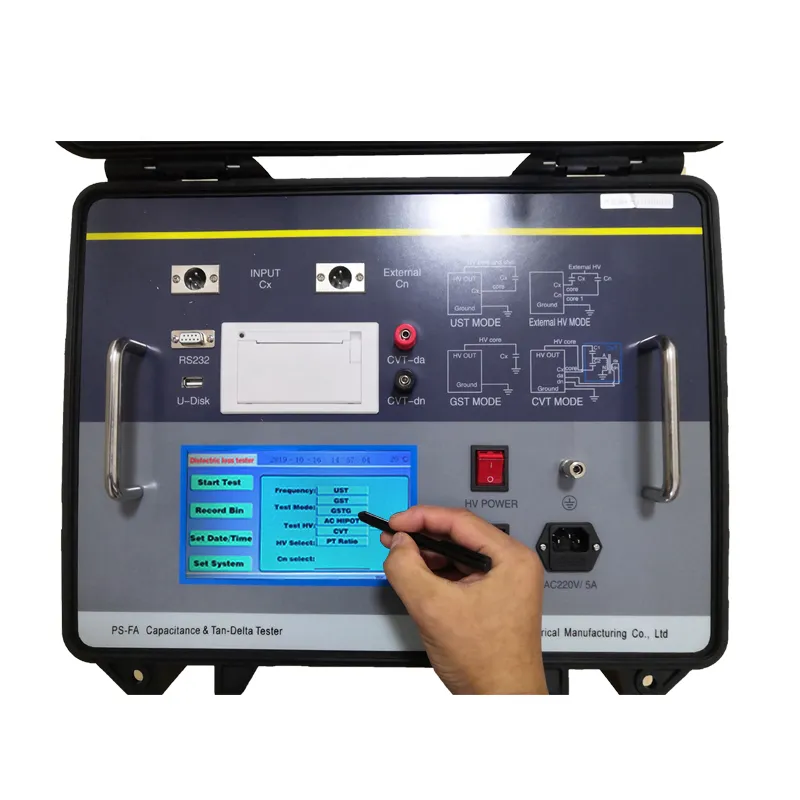TEL:
+86-0312-3189593
 English
English

Telephone:0312-3189593

Email:sales@oil-tester.com
2 月 . 12, 2025 23:43
Back to list
no load and short circuit test of transformer
Transformer testing is pivotal in ensuring the longevity and performance of electrical systems. Two fundamental tests often performed are the No Load Test and the Short Circuit Test. These tests, each with unique methodologies and purposes, are essential in assessing a transformer’s operational characteristics.
A Short Circuit Test, in contrast, is utilized primarily to establish the copper losses and equivalent resistance of the transformer. This test is performed by shorting the transformer's secondary winding while applying a reduced voltage to the primary winding adequate to circulate the normal full-load current. Copper losses, which cause energy dissipation in the form of heat, are vital for determining the natural heating effect within the transformer when operational at full load. Engineers perform this test to directly capture the impacts of resistive heating in the windings, which factor significantly into efficiency margins. During the Short Circuit Test, it is critical to precisely regulate the applied voltage, ensuring it facilitates full-load current flow without exceeding voltage limits that could endanger the apparatus. The voltage required is typically only a fraction of the rated value, but the current is significant, allowing for accurate copper loss measurement. The test yields critical data about the winding resistance and watt-meter readings that reflect total copper loss. These measurements aid in tailoring preventive maintenance schedules and in designing cooling strategies to manage temperature rise during regular operations, maintaining overall integrity and performance. Therefore, the combination of No Load and Short Circuit Tests provides an invaluable portrait of a transformer’s operational and thermal efficiency, helping engineers and technicians predict how the transformer will behave under various operational stresses. They form the foundation for designing capable transformer systems capable of withstanding the rigors of modern electricity distribution challenges. Employing these tests aids in optimizing performance, bolstering system safety, and extending the service life of transformers, making them indispensable aspects of transformer evaluation and maintenance strategies. Conclusively, by adopting a holistic approach that balances the insights from No Load and Short Circuit Tests, one can enhance the reliability and operational efficiency of transformers markedly. These tests not only ensure safe and efficient transformer performance but also refine predictive maintenance protocols, significantly reducing unscheduled downtimes and operational costs. By applying systematic test procedures, and leveraging expert measurements, these evaluations become the cornerstone of strategic asset management within electrical infrastructures across diverse industries.


A Short Circuit Test, in contrast, is utilized primarily to establish the copper losses and equivalent resistance of the transformer. This test is performed by shorting the transformer's secondary winding while applying a reduced voltage to the primary winding adequate to circulate the normal full-load current. Copper losses, which cause energy dissipation in the form of heat, are vital for determining the natural heating effect within the transformer when operational at full load. Engineers perform this test to directly capture the impacts of resistive heating in the windings, which factor significantly into efficiency margins. During the Short Circuit Test, it is critical to precisely regulate the applied voltage, ensuring it facilitates full-load current flow without exceeding voltage limits that could endanger the apparatus. The voltage required is typically only a fraction of the rated value, but the current is significant, allowing for accurate copper loss measurement. The test yields critical data about the winding resistance and watt-meter readings that reflect total copper loss. These measurements aid in tailoring preventive maintenance schedules and in designing cooling strategies to manage temperature rise during regular operations, maintaining overall integrity and performance. Therefore, the combination of No Load and Short Circuit Tests provides an invaluable portrait of a transformer’s operational and thermal efficiency, helping engineers and technicians predict how the transformer will behave under various operational stresses. They form the foundation for designing capable transformer systems capable of withstanding the rigors of modern electricity distribution challenges. Employing these tests aids in optimizing performance, bolstering system safety, and extending the service life of transformers, making them indispensable aspects of transformer evaluation and maintenance strategies. Conclusively, by adopting a holistic approach that balances the insights from No Load and Short Circuit Tests, one can enhance the reliability and operational efficiency of transformers markedly. These tests not only ensure safe and efficient transformer performance but also refine predictive maintenance protocols, significantly reducing unscheduled downtimes and operational costs. By applying systematic test procedures, and leveraging expert measurements, these evaluations become the cornerstone of strategic asset management within electrical infrastructures across diverse industries.
Previous:
Latest news
-
Differences between open cup flash point tester and closed cup flash point testerNewsOct.31,2024
-
The Reliable Load Tap ChangerNewsOct.23,2024
-
The Essential Guide to Hipot TestersNewsOct.23,2024
-
The Digital Insulation TesterNewsOct.23,2024
-
The Best Earth Loop Impedance Tester for SaleNewsOct.23,2024
-
Tan Delta Tester--The Essential Tool for Electrical Insulation TestingNewsOct.23,2024





